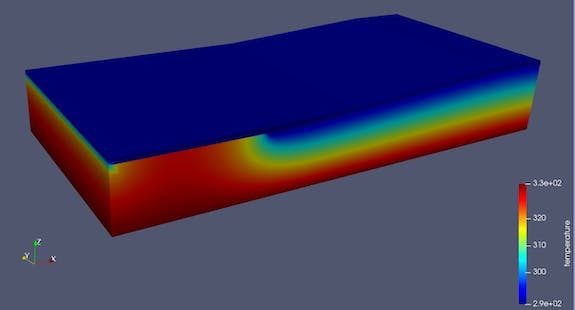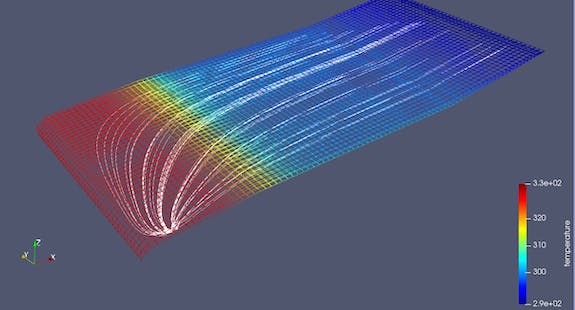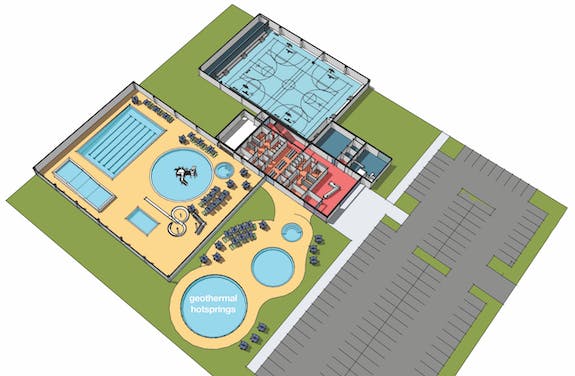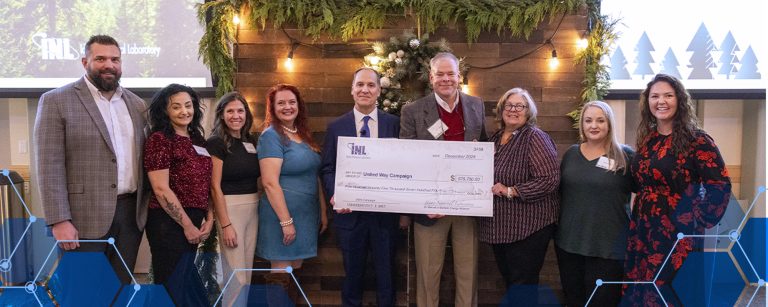For millions of years, the earth’s crust has moved over the Yellowstone hot spot, shaping the landscapes of Oregon, Nevada, Idaho, Montana and Wyoming.
The hot spot has spawned major volcanic eruptions, blanketed large portions of the United States in ash and created some the region’s most spectacular landmarks including Craters of the Moon National Monument and Yellowstone National Park.
Now, a researcher at Idaho National Laboratory is trying to help Teton Valley, Idaho, harness a tiny percentage of the hot spot’s power combined with snowmelt from the Tetons to build a badly needed aquatics center.
Teton Valley—made up of the towns of Driggs, Victor and Tetonia, Idaho, and Alta, Wyoming—is a world-class destination for outdoor recreation including skiing, mountain biking, fishing and hiking.
What Teton Valley doesn’t have is a community pool. Parents who want to teach their kids to swim must either shell out big bucks for access to private pools or drive to neighboring communities. The same goes for swim teams, recreational swimmers and people who might benefit from aquatic therapy.
Could geothermal energy work here?

With funding from INL and data from a decades-old abandoned exploration well, the lab’s geothermal program manager, Rob Podgorney, was able to donate his expertise by performing a geothermal assessment and modeling the heat flow beneath a portion of the Valley.
While the exploration well never produced any fossil fuels, “the water pressure was so high that hot water gushed out of the well,” Podgorney said.
Using a U.S. Geological Survey report and data from the well, Podgorney and his team created a model of the valley’s potential for a geothermal well. While the model doesn’t confirm the area’s geothermal potential for certain—Podgorney called the study a “high-level sniff test”—the results were very promising.
The community will likely know for sure next year. Another well, proposed for the spring of 2021 and paid for with private donations, will provide water for a new aquatics center planned for a plot of land on the road leading to Grand Targhee Resort.
If that well confirms the results of Podgorney’s study, the Teton Valley community could have access to a geothermal resource that would allow the aquatics center to operate with few carbon emissions while paying for most, if not all, of the operating and utility costs.
How’d they get so lucky?
Teton Valley’s geothermal potential is the result of a rare combination of the geology of the Tetons and the geophysics of the hot spot, said Richard Weinbrandt, a retired petroleum engineer and board member of Teton Valley Aquatics, a nonprofit formed to design, build and operate an aquatics facility for the community.
Water from the Tetons seeps into Madison Limestone, permeable rock formed hundreds of millions of years ago that runs along the crest the Teton Range. (The largest mountains in the Tetons—Grand Teton, Mount Owen, Middle Teton, South Teton, etc., are a mixture of granite and metamorphic rock).
In theory, the snow that melts on the top of, say, Fred’s Mountain just east of Driggs, would travel underground through the limestone all the way to the valley floor. A “cap” of tight sediments deposited in the basin over the last 10,000 years traps heat from the hot spot and maintains a constant pressure derived from “a column of fluid at 10,000 feet above sea level,” Weinbrandt said.
“To combine the gravitational energy of the recharge with the Yellowstone hot spot is extremely rare,” he said. “There’s not many places with 10,000-foot recharge 10 or 12 miles from the discharge point.”
What did INL study discover?
Podgorney’s task was to see if data from the exploration well and the USGS survey matched a model of how the valley’s geology interacts with water flow from adjacent mountains. Does the system provide a sustainable source of hot water for the aquatics center?

The results were encouraging. The data points to two distinct reservoirs, a shallow reservoir and a deep reservoir.
Based on Podgorney’s model, the deep reservoir could provide a thousand gallons per minute of water at a temperature of 130 degrees Fahrenheit for at least 10 years. The water will likely “flow for a long period of time at a flow rate and temperature that will allow them to operate the aquatic center,” Podgorney said.
Podgorney’s team also tried to determine whether the water itself might be suitable for a swimming facility. “Minerals can dissolve and the water can get nasty,” he said. “We looked at the water chemistry and we compared the rock type with nearby hot springs and cold springs. The chemistry should be favorable as well.”
While the results are preliminary, there might be enough water flow from the proposed well to power more than just the aquatics center. “I’m betting there will be a lot of excess heating capacity that might be able to heat houses and businesses downtown,” Podgorney said.
For comparison, Boise, Idaho’s district heating system has run off wells that have produced 180-degree Fahrenheit water for roughly 100 years.
A huge contribution

While the Teton Valley Aquatics board plans to build a community pool regardless of whether the center can harness geothermal energy, Podgorney’s study was “a huge contribution,” said Weinbrandt. It was funded by the lab’s Technical Assistance Program, which makes it possible for small business and state or local governments to get a little free help from INL scientists and engineers.
If the INL study holds up, adding a geothermal well could save the facility about $140,000 a year in utility costs. Add to that the potential for district heating or generating electricity from the geothermal well and the aquatics center could be revenue neutral, according to a feasibility study commissioned by the nonprofit.
Outdoor hot tubs could provide a tourist attraction similar to other Idaho aquatics facilities that rely on geothermal energy such as Heise Hot Springs and Lava Hot Springs. “Imagine sitting in a hot pool in a snowstorm,” Weinbrandt said.
The next steps
Weinbrandt and his colleagues have begun fundraising for the well that could confirm the INL report. The drilling rig will need to drill down about 2,000 feet before it encounters the Madison Limestone that contains the deep reservoir of hot water for the aquatics center.
“We’ll be able to evaluate the reservoir and measure the flow rate while we’re drilling,” Weinbrandt said. “If we start seeing 120-degree temperatures, that’s obviously a good thing.”
The well would then be donated to the town of Driggs, which is a partner in the project.
As for Podgorney, he plans to extend his expertise — on a volunteer basis. He and Weinbrandt are hoping to continue modeling the geothermal potential of the site as the project progresses.
“I’m on board whether we have the INL funds or not,” Podgorney said. “I think it’s a cool thing.”







